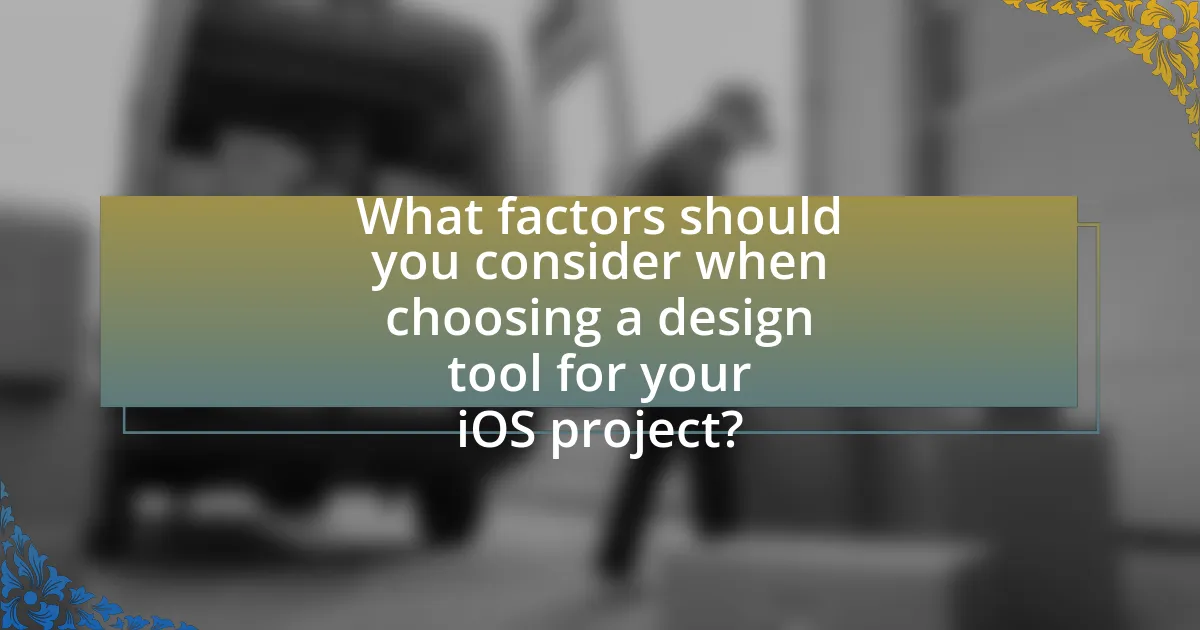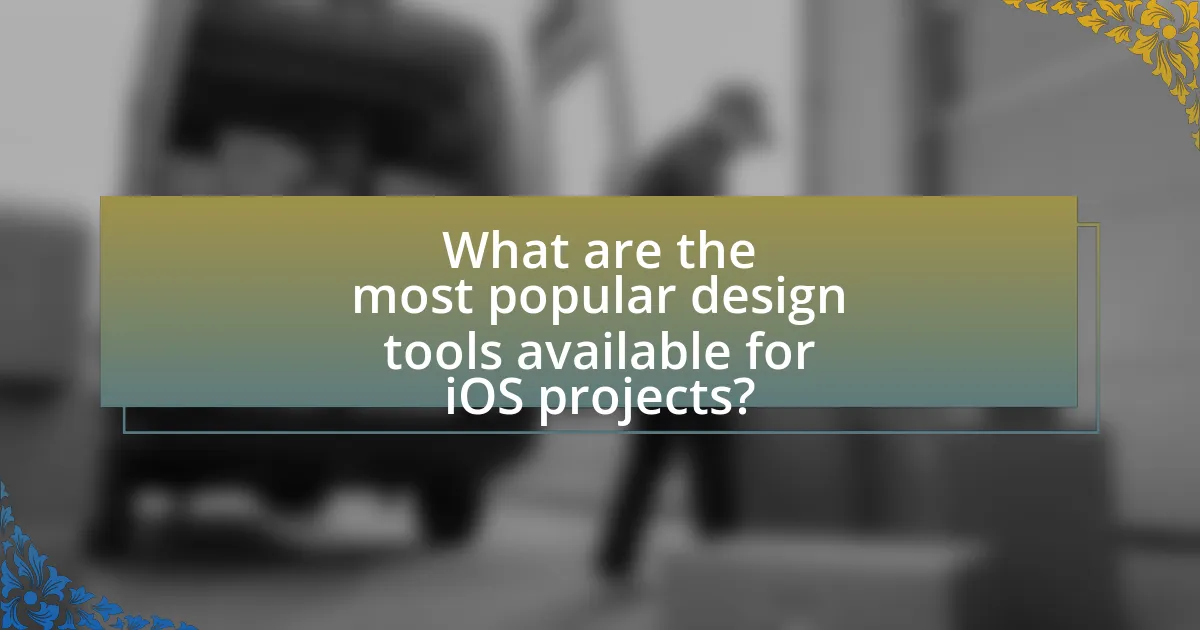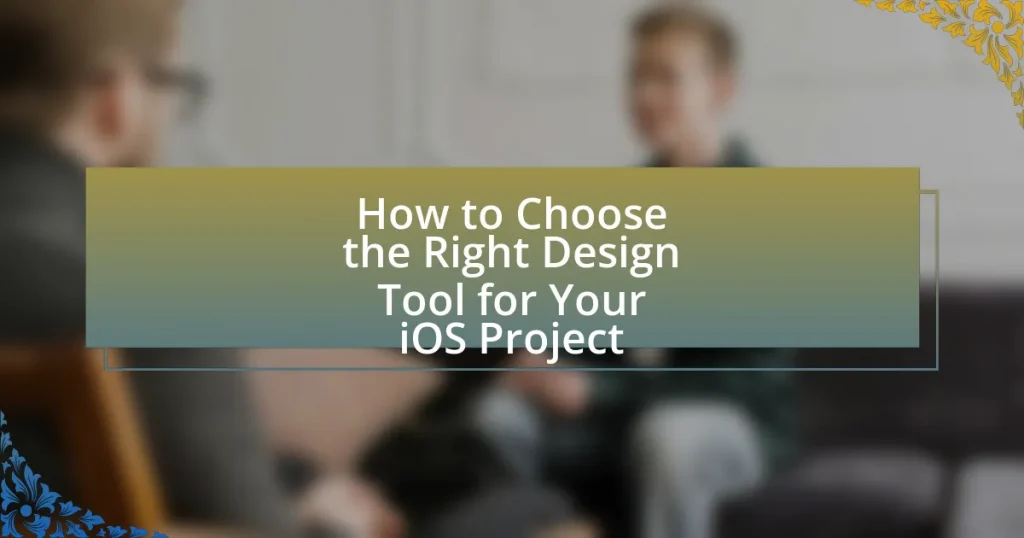The article focuses on selecting the appropriate design tool for iOS projects, emphasizing key factors such as compatibility with iOS design guidelines, ease of use, collaboration features, and integration with development tools. It discusses how the features of design tools can impact project efficiency and user experience, highlighting essential functionalities like prototyping capabilities and user-friendly interfaces. Additionally, the article compares popular design tools such as Sketch, Figma, Adobe XD, and InVision, while addressing pricing models and best practices for evaluation. It also outlines common pitfalls to avoid during the selection process, ensuring that teams make informed decisions that enhance productivity and project outcomes.

What factors should you consider when choosing a design tool for your iOS project?
When choosing a design tool for your iOS project, consider compatibility with iOS design guidelines, ease of use, collaboration features, and integration with development tools. Compatibility ensures that the design tool aligns with Apple’s Human Interface Guidelines, which is crucial for creating user-friendly applications. Ease of use affects the learning curve and productivity of the design team; tools like Sketch and Figma are known for their intuitive interfaces. Collaboration features are essential for team projects, allowing multiple designers to work simultaneously and provide feedback in real-time. Integration with development tools, such as Xcode, streamlines the workflow from design to development, enhancing efficiency and reducing errors.
How do the features of design tools impact your iOS project?
The features of design tools significantly impact your iOS project by enhancing collaboration, streamlining workflows, and improving user interface design. For instance, tools that offer real-time collaboration enable multiple team members to work simultaneously, reducing the time needed for feedback and revisions. Additionally, features like component libraries and design systems ensure consistency across the app, which is crucial for user experience. Research indicates that using design tools with prototyping capabilities can lead to a 30% reduction in development time, as they allow for early testing of user interactions. Thus, the right design tool can directly influence the efficiency and quality of your iOS project.
What essential features should a design tool have for iOS development?
A design tool for iOS development should have features such as a user-friendly interface, support for vector graphics, prototyping capabilities, and integration with development environments. A user-friendly interface ensures that designers can efficiently create and modify designs without a steep learning curve. Support for vector graphics is crucial as it allows for scalable designs that maintain quality across different screen sizes. Prototyping capabilities enable designers to create interactive mockups, facilitating user testing and feedback. Integration with development environments, such as Xcode, streamlines the workflow between design and development, ensuring that assets are easily accessible and usable. These features collectively enhance the design process and improve collaboration between designers and developers.
How do collaboration features influence team dynamics in iOS projects?
Collaboration features significantly enhance team dynamics in iOS projects by facilitating communication, improving workflow efficiency, and fostering a sense of shared ownership among team members. These features, such as real-time editing, version control, and integrated feedback systems, enable developers and designers to work concurrently, reducing the time spent on revisions and misunderstandings. For instance, tools like Figma and GitHub allow multiple users to contribute simultaneously, which has been shown to increase productivity by up to 30% in software development environments. Furthermore, the transparency provided by collaboration tools helps build trust and accountability within the team, leading to improved morale and a more cohesive working environment.
Why is user experience important in selecting a design tool?
User experience is crucial in selecting a design tool because it directly impacts the efficiency and effectiveness of the design process. A design tool that prioritizes user experience enables designers to navigate features intuitively, reducing the learning curve and enhancing productivity. Research indicates that tools with a strong focus on user experience can lead to a 20-30% increase in design efficiency, as designers spend less time troubleshooting and more time creating. Therefore, selecting a design tool that emphasizes user experience is essential for optimizing workflow and achieving high-quality design outcomes.
How does the user interface of a design tool affect productivity?
The user interface of a design tool significantly affects productivity by influencing the ease of use and efficiency of the design process. A well-designed user interface allows designers to navigate tools and features intuitively, reducing the time spent on learning and troubleshooting. For instance, studies have shown that tools with streamlined interfaces can increase task completion speed by up to 30%, as users can focus more on creativity rather than technical barriers. Additionally, a user-friendly interface minimizes cognitive load, enabling designers to maintain focus and enhance their workflow, ultimately leading to higher quality outputs in less time.
What role does user feedback play in the effectiveness of a design tool?
User feedback is crucial for the effectiveness of a design tool as it directly informs improvements and adaptations to meet user needs. By collecting and analyzing feedback, developers can identify usability issues, feature requests, and overall satisfaction levels, which leads to more intuitive and efficient design tools. For instance, a study by Nielsen Norman Group found that user-centered design, which heavily relies on user feedback, can increase usability by up to 50%. This demonstrates that incorporating user insights not only enhances the tool’s functionality but also aligns it more closely with user expectations, ultimately leading to better design outcomes.

What are the most popular design tools available for iOS projects?
The most popular design tools available for iOS projects include Sketch, Figma, Adobe XD, and InVision. Sketch is widely used for its vector editing capabilities and extensive plugin ecosystem, making it a favorite among UI/UX designers. Figma stands out for its collaborative features, allowing multiple users to work on designs in real-time, which is essential for team projects. Adobe XD offers integration with other Adobe products and robust prototyping features, appealing to designers familiar with the Adobe suite. InVision is known for its prototyping and user testing capabilities, enabling designers to create interactive mockups easily. These tools are favored in the industry due to their specific functionalities that cater to the needs of iOS design projects.
How do different design tools compare in terms of functionality?
Different design tools vary significantly in functionality, impacting their suitability for iOS projects. For instance, Sketch excels in vector editing and offers a robust plugin ecosystem, making it ideal for UI/UX design. Adobe XD provides strong collaboration features and integration with other Adobe products, enhancing workflow efficiency. Figma stands out with its real-time collaboration capabilities, allowing multiple users to work simultaneously, which is beneficial for team projects. In contrast, InVision focuses on prototyping and user testing, providing tools for feedback and iteration. Each tool’s unique features cater to different aspects of the design process, influencing the choice based on project requirements and team dynamics.
What are the strengths and weaknesses of Sketch for iOS design?
Sketch for iOS design has notable strengths and weaknesses. Its strengths include a user-friendly interface that facilitates efficient design workflows, robust vector editing capabilities, and a strong ecosystem of plugins that enhance functionality. These features make it particularly effective for creating high-fidelity prototypes and UI designs tailored for iOS applications. Conversely, weaknesses of Sketch include its limited collaboration features compared to cloud-based tools, which can hinder teamwork, and its exclusive compatibility with macOS, restricting access for Windows users. These limitations can impact team dynamics and accessibility in diverse development environments.
How does Figma facilitate collaboration in iOS design projects?
Figma facilitates collaboration in iOS design projects through its real-time editing capabilities, allowing multiple users to work on the same design simultaneously. This feature enables instant feedback and communication among team members, enhancing the design process. Additionally, Figma’s cloud-based platform ensures that all changes are automatically saved and accessible to all collaborators, eliminating version control issues. The platform also supports commenting directly on designs, which streamlines discussions and decision-making. These collaborative features are essential for teams working on iOS projects, as they improve efficiency and foster creativity.
What pricing models should you consider when selecting a design tool?
When selecting a design tool, consider subscription-based, one-time purchase, and freemium pricing models. Subscription-based models, such as Adobe Creative Cloud, provide ongoing updates and support, which can be beneficial for long-term projects. One-time purchase models, like Sketch, offer a single payment for lifetime access, appealing to users who prefer not to commit to recurring fees. Freemium models, exemplified by Figma, allow users to access basic features for free while offering premium features at a cost, enabling users to evaluate the tool before investing. Each model has distinct advantages that can align with different project needs and budget constraints.
How do subscription-based models differ from one-time purchases?
Subscription-based models provide ongoing access to a product or service for a recurring fee, while one-time purchases grant permanent ownership of a product for a single payment. Subscription models often include regular updates, customer support, and additional features as part of the service, which can lead to lower upfront costs but higher long-term expenses. In contrast, one-time purchases require a larger initial investment but do not incur ongoing fees, making them potentially more cost-effective over time for users who do not need continuous access or updates. This distinction is crucial for users selecting design tools for iOS projects, as it impacts budgeting and long-term usability.
What are the cost implications of using free versus paid design tools?
Using free design tools incurs no direct financial cost, while paid design tools typically require a subscription or one-time purchase fee. Free tools may limit features, support, and updates, potentially leading to increased long-term costs due to inefficiencies or the need for additional tools. In contrast, paid tools often provide advanced functionalities, customer support, and regular updates, which can enhance productivity and project quality, ultimately justifying their expense. For example, Adobe Creative Cloud, a paid tool, offers extensive features and integrations that can streamline workflows, whereas free alternatives may lack these capabilities, resulting in potential delays and additional costs in project timelines.

How can you evaluate the right design tool for your specific needs?
To evaluate the right design tool for your specific needs, first identify the specific requirements of your iOS project, such as collaboration features, user interface design capabilities, and integration with development tools. Next, compare available design tools based on these criteria, focusing on user reviews and case studies that highlight their effectiveness in similar projects. For instance, tools like Sketch and Figma are often praised for their collaborative features and ease of use in iOS design, as evidenced by numerous user testimonials and industry reports. By aligning your project requirements with the strengths of each tool, you can make an informed decision that best suits your design needs.
What criteria should you use to assess design tools for your iOS project?
To assess design tools for your iOS project, prioritize criteria such as compatibility with iOS design guidelines, collaboration features, user interface intuitiveness, and integration with development environments. Compatibility ensures that the tool aligns with Apple’s Human Interface Guidelines, which is crucial for creating user-friendly applications. Collaboration features facilitate teamwork, allowing multiple designers to work simultaneously, which is essential for efficient project management. User interface intuitiveness impacts the learning curve and usability of the tool, directly affecting productivity. Integration with development environments, such as Xcode, streamlines the workflow between design and development, enhancing overall project efficiency. These criteria collectively ensure that the selected design tool meets the specific needs of iOS development.
How can you prioritize features based on your project requirements?
To prioritize features based on project requirements, utilize a structured framework such as the MoSCoW method, which categorizes features into Must have, Should have, Could have, and Won’t have. This approach allows teams to focus on essential features that align with project goals and user needs. For instance, a study by the Project Management Institute indicates that projects with clearly defined priorities are 30% more likely to succeed, demonstrating the effectiveness of prioritization methods in achieving project objectives.
What methods can you use to test design tools before making a decision?
To test design tools before making a decision, you can utilize methods such as free trials, user reviews, and comparative analysis. Free trials allow users to explore the tool’s features and usability firsthand, providing direct experience that can inform their decision. User reviews offer insights from other designers who have used the tools, highlighting strengths and weaknesses based on real-world applications. Comparative analysis involves evaluating multiple tools side-by-side based on criteria such as functionality, ease of use, and pricing, which helps in identifying the best fit for specific project needs. These methods collectively ensure a well-informed choice when selecting a design tool for an iOS project.
What are some best practices for choosing a design tool for iOS projects?
When choosing a design tool for iOS projects, prioritize tools that support iOS-specific design guidelines and offer collaboration features. Tools like Sketch, Figma, and Adobe XD are popular because they provide extensive libraries for iOS components, enabling designers to create interfaces that align with Apple’s Human Interface Guidelines. Additionally, consider the tool’s integration capabilities with development environments, as seamless handoff between design and development can enhance workflow efficiency. Research indicates that tools with strong collaboration features, such as real-time editing and feedback, significantly improve team productivity and project outcomes.
How can you involve your team in the decision-making process?
Involving your team in the decision-making process can be achieved by facilitating open discussions and encouraging collaborative brainstorming sessions. This approach allows team members to share their insights and perspectives, which can lead to more informed decisions. Research indicates that teams that engage in collaborative decision-making often experience higher satisfaction and better outcomes, as diverse viewpoints contribute to a more comprehensive understanding of the challenges and opportunities at hand. For instance, a study published in the Harvard Business Review found that teams that leverage collective intelligence outperform individual decision-makers by 30%.
What common pitfalls should you avoid when selecting a design tool?
When selecting a design tool, avoid common pitfalls such as prioritizing features over usability, which can lead to a steep learning curve and decreased productivity. Many designers find themselves overwhelmed by complex tools that offer extensive features but lack intuitive interfaces. Additionally, neglecting to consider team collaboration capabilities can hinder project efficiency, as tools that do not support real-time collaboration can create communication barriers. Another pitfall is failing to evaluate integration with existing workflows and software, which can result in compatibility issues and disrupt the design process. Lastly, overlooking budget constraints can lead to overspending on tools that may not deliver proportional value, as many design tools have subscription models that can accumulate significant costs over time.









